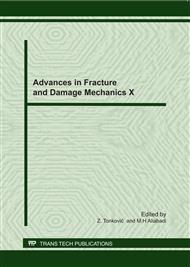p.577
p.581
p.585
p.589
p.593
p.597
p.601
p.605
p.609
Energy Principle in Crack Propagation
Abstract:
Fracture mechanics is an engineering discipline, which originated from Griffith energy-balance concept. The energy method is the most powerful analytical tool for fracture mechanics. Starting from energy principle in crack propagation, quasi-static governing equations and energy release rate of DCB specimen can be derived by energy principle in this paper. Finally, some correlative problems are discussed.
Info:
Periodical:
Pages:
593-596
Citation:
Online since:
September 2011
Authors:
Price:
Сopyright:
© 2012 Trans Tech Publications Ltd. All Rights Reserved
Share:
Citation:


